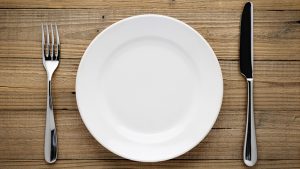From my years of presenting at PaleoFx in Austin Texas, I have learned some things that have changed my life. The first blog post about my conference this year is here. I am including a couple more pearls for you here: Fasting and Ketosis meets all the cool Paleo and Primal Food hacks. I hope you enjoy. – Rich
FASTING
 Fasting is how we are wired. No products, just eat less frequently. I think we are wired to eat once daily. But I believe we have evolved well over the past couple thousand years to eat twice daily. More than three times daily is simply crazy talk. There is not a paleo, ancestrally minded nutritionist who agrees with the failed American dogma of frequent snacks. I published a Paleo article awhile back about eating only 2 meals per day to help reverse type 2 diabetes.
Fasting is how we are wired. No products, just eat less frequently. I think we are wired to eat once daily. But I believe we have evolved well over the past couple thousand years to eat twice daily. More than three times daily is simply crazy talk. There is not a paleo, ancestrally minded nutritionist who agrees with the failed American dogma of frequent snacks. I published a Paleo article awhile back about eating only 2 meals per day to help reverse type 2 diabetes.
We Paleo folk use terms like fat adapted, which means that your body can easily tap into fat stores for energy. Which is hand, because it is a loaded bank account. A healthy man or woman has well over 100,000 calories as stored fat on the body. You can be sure that you’ll make it between meals without food. If you have this working right, your TG:HDL ratio on your fasting lipid panel should be 0.5-1.0, and your fasting insulin should be well below 8 uIU/mL.
The conference this year was heavily weighted toward the term “ketosis”. Ketone form when stored fats are metabolically burned as fuel. How do you know if you are significantly burning fats—that you are fat adapted? Check for ketones. There were lots of tools for this, blood analyzers, breath analyzers. And of course a simple and super cheap way to measure is through urine. Ol’ Dr. Atkins make this popular. Pee on the strip and assure you show at least some ketone production. Here is a simple ketone test strip for <$10: [https://amzn.to/2HODUvb]
And how do you get to this “ketogenic state”?
- Fast – Skip a meal
- Do a strength workout that is metabolically strenuous
- Have a little caffeine drink instead of breakfast
- Keep carbs to <40 grams +/- per day, carbohydrates are the foodstuff that block fat-burning
- Use dietary fats as your dominant calorie, this is a Low-Carb-High-Fat (LCHF) diet
[Anyone who has followed the “severe insulin resistance” guideline in The Blood Code book [https://amzn.to/2HLeP8c] has been in ketosis as the maximum dietary carb is 40grams per day]
Beware though, the conference was full of products that contain ketones in supplement / pill / powder form. The process of getting into ketosis is likely where the benefit lies, not the end product ketones themselves, so I do not recommend adding ketones for any general health reason. Although, supplemental ketone salts are being studied for complementary cancer treatment—a therapy that might hold some promise for some. I believe we all benefit from cycling in and out of this ketogenic state, not necessarily remaining in it non-stop for years. And for those with body fat gains, high blood sugars and cholesterol/triglyceride issues, this will be a fabulous exercise that exercises you toward a healthier metabolism long-term.
Cool Paleo inspired foods
Some divine foods were at this year’s conference. Once again, I like the EPIC company products. Prior to arriving into Texas, I bought an EPIC bison bar in JFK airport…that with a bag nuts and some radishes and snap peas was my travel lunch. Grass-fed and sustainability is part of every product they produce, and it helps that they have one of the coolest vendor booths of all, with a full sized beautiful, taxidermy American Bison. In my kitchen now, EPIC is represented with a bag of baked pork skins and a beef apple-bacon-bar (there for my next on-the-go meal).
I also keep lard and ghee in the kitchen. These are extremely stable cooking oils that I use on any hot skillet. Last night I used ghee with the string beans and mushrooms and lard in the pan in which I seared the steak. I usually top-dress with olive oil after high heat cooking is done.
Collagen! Geez this vendor hall was full of collagen this year. Mixed with veggie juice, mixed with chai tea, mixed with coffee. I was downing about 20 grams of collagen daily while at the conference…and I swear my nails and hair are more lustrous. I have been looking through the research to see if collagen has a downside or is a useful alternative to other protein powders such as whey. Our primal ancestors got their collagen buy chewing on the ends of meat, poultry and fish bones. More recently, collagen would come from a hearty broth made from these same foodstuffs. Collagen, no doubt, is inferior to these foods but does offer a convenient protein supplement when needed. For the past couple years, I have trusted and continue to trust the Vital Proteins brand. They even have a collagen-coconut creamer to add to your coffee, it’s worth checking out.
While meat- based protein dominated the vendor floor, fish still represents I healthy fatty protein for our diet. Wild planet is one of my favorite brands, they use sustainably caught, smaller fish in their canned products, and the mercury content is impressively low. They also pack their fish without oil or water added, the healthy omega-3 fat remains in the can. One can of albacore, for example, contains the equivalent of over two capsules of high potency fish oil. I find some of their products in my supermarket, but Amazon has them in bulk too. I’ll include links below.

Nuts represent a huge part of the paleo diet—high fat, ample fiber, and crunchy. I stick with my staples in the kitchen, pecans—soaked and re-dried, roasted skinned hazelnuts, sunflower seeds, pine nuts, blanched almonds and pumpkin seeds. But since this weekend, I again tasted the lovely PILI nut – sprouted and salted, this is like putting a pastry on your tongue. It just melts seductively. They are not priced for me to consider them a daily staple, but if I am looking for a housewarming present for a friend, a bag of PILI nuts is like nothing you typically buy for yourself. The Barefoot Provisions catalog has a better price than the company directly – look for the link below too.
Like most conferences, the food in the vendor all a relatively processed—ironic given the simple cuisine of our ancestors. Since arriving home, I have enjoyed the mid spring abundance of vegetables. Prepared with ample dietary fats and dense protein, meals are simple, unprocessed and nutritious, probably a lot like my great grandmother Nonna.
- For Wild Planet products – I like the skipjack in cans – found here at Amazon
- Barefoot Provisions has curated all the best Paleo products, like:
- EPIC bars are here
- The Seductive PILI nuts
- The Collagen Creamer or other collagen packets are here
Look around your local food resources too, many farmer are now selling their own lard (from pigs) and tallow (from Cows) and even duck fat. Don’t forget to support your local food producers when possible.



Comments are closed.